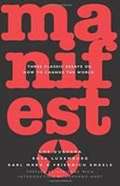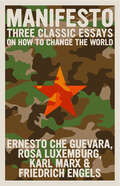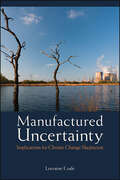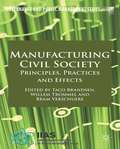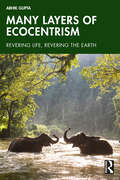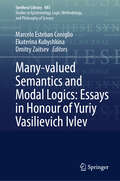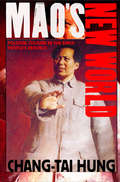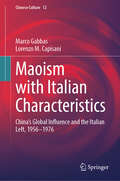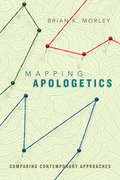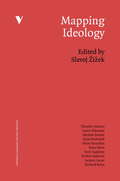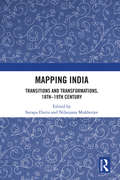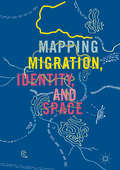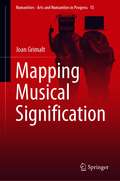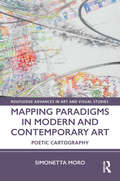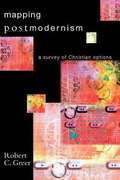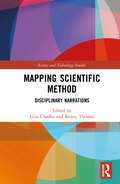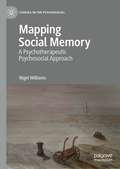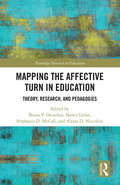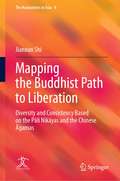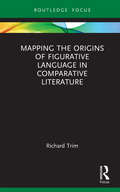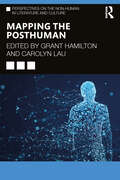- Table View
- List View
Manifesto: Three Classic Essays on How to Change the World
by Friedrich Engels Karl Marx Ernesto Che Guevara Rosa Luxemburg"Let's be realists, let's dream the impossible." Che Guevara's words summarize the radical vision of the four famous rebels presented in this book: Marx and Engels' "Communist Manifesto," Rosa Luxemburg's "Reform or Revolution" and Che Guevara's "Socialism and Humanity." Far from being lifeless historical documents, these manifestos for revolution will resonate with a new generation also seeking a better world. "The world described by Marx and Engels... is recognizably the world we live in 150 years later.
Manifesto: Three Classic Essays on How to Change the World (The Che Guevara Library)
by Friedrich Engels Karl Marx Ernesto Che Guevara Rosa LuxemburgThe three texts this book, all written in vastly different eras —The Communist Manifesto (1848) by Marx and Engels, Reform or Revolution (1899) by Rosa Luxemburg and Socialism and Man in Cuba (1965) by Ernesto Che Guevara—illuminate socialist ideas of the 19th and 20th centuries.For a new generation of activists, these are classic revolutionary writings by four famous rebels, including The Communist Manifesto by Karl Marx and Friedrich Engels; Reform or Revolution by Rosa Luxemburg; and Che Guevara&’s Socialism and Man in Cuba. Includes an introduction by Cuban Marxist intellectual Armando Hart and a preface by US radical poet Adrienne Rich. The essays in this book, Manifesto, were written by three relatively young people—Karl Marx when he was 30, Rosa Luxemburg at 27, Che Guevara at the age of 37. Born into different historical moments and different generations, they shared an energy of hope, an engagement with history, a belief that critical thinking must inform action, and a passion for the world and its human possibilities. Here are urgent conversations from the past that are still being carried on, among new voices, throughout the world.
Manifiesto animalista
by Corine PelluchonLa violencia contra los animales es un ataque directo a nuestra humanidad. Eso demuestra Corine Pelluchon en este breve ensayo, pragmático, controvertido y que supone una contribución radical a la ética y la filosofía política. <P><P>Luchar contra el maltrato animal es rebelarse contra una sociedad basada en la explotación, y por ello la causa animalista es una cuestión política mayor que nos concierne a todos, más allá de ideologías o conflictos de intereses. <P>Con un estilo vivo, persuasivo e inspirador, la autora propone un camino posible y factible para llevar el debate a la esfera política con tanta claridad y urgencia como sea posible.
Manifiesto animalista: Politizar la causa animal
by Corine PelluchonLa violencia contra los animales es un ataque directo a nuestra humanidad. Eso demuestra Corine Pelluchon en este breve ensayo, pragmático, controvertido y que supone una contribución radical a la ética y la filosofía política. «Un libro intenso, pese a su brevedad, de acción, llamado a marcar época. [...] Una propuesta clara y concisa para avanzar de manera decisiva en nuestra relación con los animales».Jacinto Antón, El País Luchar contra el maltrato animal es rebelarse contra una sociedad basada en la explotación, y por ello la causa animalista es una cuestión política mayor que nos concierne a todos, más allá de ideologías o conflictos de intereses. Con un estilo vivo, persuasivo e inspirador, la autora propone un camino posible y factible para llevar el debate a la esfera política con tanta claridad y urgencia como sea posible. Reseñas:«No exento de polémica, Manifiesto animalista, no pretende aleccionar moralmente a nadie, ni siquiera pretende convertirnos en animalistas, sino poner al lector, ciudadano, al fin y al cabo, en la meta de salida de un proceso de auto conversión e introspección. [...] Un cambio a varios niveles y que venga desde diferentes ámbitos: una nueva era, la de los seres vivientes, que deje atrás el antropocentrismo y que ponga el acento en nuestra manera de habitar la tierra».Queralt Castillo Cerezuela, Público«Un texto corto, directo y con propuestas muy concretas. Un panfleto que rompe la brecha entre la teoría y la práctica y va encaminado hacia la acción. Y en su país han recogido el guante. [...] La mejor muestra de que la lucha por los derechos de los animales ha traspasado ya la linde del mero activismo».Paula Corroto, El País «El ensayo dela doctora en filosofía Pelluchon irrumpe en la sociedad del siglo XXI como una verdadera catarsis del espíritu».LA.Network «Un nuevo paradigma del movimiento animalista mundial. [...] Un libro intenso, pese a su brevedad, de acción, llamado a marcar época y que constituye a la vez un estado de la cuestión, una declaración de intenciones y una propuesta clara y concisa para avanzar de manera decisiva en nuestra relación con los animales».Jacinto Antón, El País «La voz del animalismo».Núria Navarro, El Periódico«Un nombre de referencia del antiespecismo que busca convencer, no vencer a cualquier precio. [...] Manifiesto animalista resuena más necesaria que nunca.»Igor López, ICON «Corine Pelluchon lo explica todo absolutamente bien en apenas un centenar de páginas: para ser una alternativa válida, politizar la causa animal es imprescindible.»Luce Lapin, Charlie Hebdo«El objetivo principal de la autora está completamente logrado en este Manifiesto animalista: le da al lector las claves que le permitirán ampliar el radio de acción del humanismo a los animales.»Philippe Douroux, Libération «Una perspectiva bella y ambiciosa.»Isabelle Gravillon, Femme Majuscule«Un libro de intervención política, tan comprometido como lúcido.»Robert Jules, La Tribune «Una de las muchas y grandes cualidades de este Manifiesto animalista es que, en todo momento, su proyecto está expuesto de manera perfectamente creíble y realizable. Precisamente por eso, la autora no se hace ninguna ilusión sobrela dificultad que supone introducir la cuestión animal en el debate político.»Hicham-Stéphane Afeissa, Non Fiction
Manufactured Uncertainty: Implications for Climate Change Skepticism
by Lorraine CodeIn this provocative work, Lorraine Code returns to the idea of "epistemic responsibility," as developed in her influential 1987 book of the same name, to confront the telling new challenges we now face to know the world with some sense of responsibility to other "knowers" and to the sustaining, nonhuman world. Manufactured Uncertainty focuses centrally on the environmental and cultural crises arising from postindustrial, man-made climate change, which have spawned new forms of passionately partisan social media that directly challenge all efforts to know with a sense of collective responsibility. How can we agree to act together, Code asks, even in the face of inevitable uncertainty, given the truly life-threatening stakes of today's social and political challenges? How can we engage responsibly with those who take every argument for an environmentally grounded epistemology as an unacceptable challenge to their assumed freedoms, comforts, and "rights?" Through searching critical dialogue with leading epistemologists, cultural theorists, and feminist scholars, this book poses a timely challenge to all thoughtful knowers who seek to articulate an expanded and deepened sense of epistemic responsibility—to a human society and a natural world embraced, together, in the most inclusive spirit.
Manufacturing Civil Society
by Taco Brandsen Willem Trommel Bram VerschuereFaced with falling social cohesion governments have sought to revitalise society by trying to reconstruct local communities, civil society and citizenship. As a result, civil society is increasingly brought within the realm of public management, subject to accountability and embedded in hierarchies the impact and origins of which this book explores
Manufacturing Political Trust: Targets and Performance Management in Public Policy
by Christina BoswellMeasurement and targets have been widely criticised as distorting policy and engendering gaming - yet they continue to be widely used in government. This book offers an original new account explaining the persistent appeal of performance measurement. It argues that targets have been adopted to address a crisis of trust in politics, through creating more robust mechanisms of accountability and monitoring. The book shows that such tools rarely have their intended effect. Through an in-depth analysis of UK targets on immigration and asylum since 2000, it shows that far from shoring up trust, targets have engendered cynicism and distrust in government. Moreover, they have encouraged intrusive forms of monitoring and reform in public administration, with damaging consequences for trust between politicians and civil servants. Despite these problems, performance measurement has now become embedded in techniques of public management. It has also become normalised as a way of framing policy problems and responses. Thus despite their acknowledged problems, targets are likely to retain their allure as techniques of political communication and governance. Employs a range of theoretical approaches from across the social and political sciences to examine the use of performance targets in public policy; Focuses on the highly topical subject of political trust, and how governments attempt to address voter mistrust in politicians and political institutions; Analyses the highly relevant subject of contemporary UK immigration and asylum to illustrate the pitfalls of using performance measurement targets.
Many Layers of Ecocentrism: Revering Life, Revering the Earth
by Abhik GuptaThis book unveils the myriad streams of ecocentric thoughts that have been flowing through the human mind – in indigenous communities, in the wisdom of philosophers, in the creative expressions of poets and writers – sometimes latent, but sometimes more explicit. The strength of this book lies in the fact that it attempts to show that ecocentrism had not emerged suddenly as a distinct line of philosophical thought or found its place among the various normative approaches toward nature, but the seeds of ecocentrism had always been running through human societies. Thus, this book not only emphasizes the “unity of life” but also reveals the inherent unity of all hues of ecocentrism. The book adopts a multidisciplinary approach, which is essential to dwell on a topic like ecocentrism which permeates the domains of disciplines as disparate as science, philosophy, religion, normative ethics, myths and folklore, poetry, and literature, among others. Despite this eclectic approach, the book attempts to maintain continuity among the chapters and present these concepts in a simple form that will be easily accessible by readers from all conceivable backgrounds. This book would be useful to the students, researchers, and faculty from the fields of ecology and environmental science, philosophy, sociology, religious studies, and literature. It will also be an indispensable companion for all nature lovers, activists, and general readers interested in the emergence and evolution of environmental thoughts.
Many-valued Semantics and Modal Logics: Essays in Honour of Yuriy Vasilievich Ivlev (Synthese Library #485)
by Marcelo Esteban Coniglio Dmitry Zaitsev Ekaterina KubyshkinaThis volume is a collection of essays related to the work of Professor Yuriy Vasilievich Ivlev, a distinguished Russian logician and philosopher renowned for his expertise in many-valued and modal logics. Notably, his groundbreaking work on quasi-matrices for logics, now recognized as non-deterministic matrices and non-deterministic semantics, emerged in the 1970s. From a philosophical standpoint, Ivlev’s research delves into the formal analysis of indeterminacy, offering a logical framework to understand how sequences of indeterminate events can yield determinate outcomes. The volume follows two complementary lines of research. Firstly, it serves as a platform for the exploration and discussion of Ivlev’s seminal contributions to the algebraic characterization of both normal and non-normal modal logics, aimed at making these insights accessible to an international audience. Secondly, it features contributions from esteemed logicians and philosophers worldwide, offering diverseperspectives on the logical analysis of indeterminacy. This comprehensive volume will appeal to scholars and researchers in logic, philosophy, and mathematics who are engaged in the study of many-valued and modal methodologies for modeling situations of indeterminacy.
Mao's New World: Political Culture in the Early People's Republic
by Chang-tai HungIn this sweeping portrait of the political culture of the early People's Republic of China (PRC), Chang-tai Hung mines newly available sources to vividly reconstruct how the Chinese Communist Party (CCP) tightened its rule after taking power in 1949. With political-cultural projects such as reconstructing Tiananmen Square to celebrate the Communist Revolution; staging national parades; rewriting official histories; mounting a visual propaganda campaign, including oil paintings, cartoons, and New Year prints; and establishing a national cemetery for heroes of the Revolution, the CCP built up nationalistic fervor in the people and affirmed its legitimacy. These projects came under strong Soviet influence, but the nationalistic Chinese Communists sought an independent road of nation building; for example, they decided that the reconstructed Tiananmen Square should surpass Red Square in size and significance, against the advice of Soviet experts sent from Moscow.Combining historical, cultural, and anthropological inquiries, Mao's New World examines how Mao Zedong and senior Party leaders transformed the PRC into a propaganda state in the first decade of their rule (1949–1959). Using archival sources only recently made available, previously untapped government documents, visual materials, memoirs, and interviews with surviving participants in the Party's plans, Hung argues that the exploitation of new cultural forms for political ends was one of the most significant achievements of the Chinese Communist Revolution. The book features sixty-six images of architecture, monuments, and artwork to document how the CCP invented the heroic tales of the Communist Revolution.
Maoism with Italian Characteristics: China's Global Influence and the Italian Left, 1956-1976 (Chinese Culture #12)
by Marco Gabbas Lorenzo M. CapisaniThis book is, primarily, a historical study that investigates why Mao’s thought took root in Italy, how it developed, and its emergence in opposition to the Italian Communist Party, with a focus on the years 1956–1976. The book also prompts reflection on how dissent has been perceived in Leftist parties more broadly, and how ‘sub-cultures’ can become prominent. The authors delve into the relations between Mao’s China and the Italian institutional Left, mindful of the fact that not all the involved parties represented monolithic clusters of consent. The book confronts a watershed of reforms or revolution, in which the Italian Communist Party embraced a non-revolutionary and parliamentary policy, and where Italian radicals took Mao’s slogans literally to argue that a revolution in Italy was not only possible, but necessary. Tracking the subsequent abandonment of Maoism in modern left-wing parties in Italy, which gradually became more distant from the working class, the authors juxtapose this to modern China, which opened up with Deng Xiaoping’s reforms and Xi Jinping’s search for rejuvenation. In presenting Italian Maoism—a largely forgotten topic and fascinating example of Western Maoism—to an English-reading audience, the authors contextualize these local historical events in a global modern perspective, linking them to the Cold War and horizontal issues, such as dissent, in a rich comparison of Italian and Chinese sources from party archives and collections. It is relevant to historians interested in the circulation of Chinese political ideas in the West, and China’s historical trajectory from the Cold War to the present.
Mapping Apologetics: Comparing Contemporary Approaches
by Brian K. MorleyEveryone believes something. But how and why do people believe? What counts as evidence? How much can be assumed or believed by faith alone? When it comes to religious faith, the questions become at once more difficult and more important. Over the centuries, Christians have offered different approaches to explaining or defending the Christian faith, a discipline known as apologetics. But it has not always been clear how different apologetic methods work, or what each approach has to offer. In this comprehensive survey, Brian Morley provides an overview of Christian apologetic approaches and how they differ. He explores the historical and philosophical underpinnings of key figures and major schools of thought, from the presuppositionalism of Cornelius Van Til to the evidentialism of Gary Habermas. Moving beyond theory, Morley also covers apologetic application, demonstrating how each view works out in practical terms. This guide covers the complexities of apologetics in a way that is accessible to the nonspecialist. Even-handed and respectful of each apologist and their contribution, this book provides the reader with a formidable array of defenses for the faith.
Mapping Equity and Quality in Mathematics Education
by Paola Valero Mellony Graven Bill Atweh Walter SecadaConcerns about quality mathematics education are often posed in terms of the types of mathematics that are worthwhile and valuable for both the student and society in general, and about how to best support students so that they can develop this mathematics. Concerns about equity are about who is excluded from the opportunity to develop quality mathematics within our current practices and systems, and about how to remove social barriers that systematically disadvantage those students. This collection of chapters summarises our learning about the achievement of both equity and quality agendas in mathematics education and to move forward the debate on their importance for the field.
Mapping Ideology
by Slavoj Zizek Nicholas Abercrombie Louis Althusser Theodor Adorno Michele BarrettFor a long time, the term "ideology" was in disrepute, having become associated with such unfashionable notions as fundamental truth and the eternal verities. The tide has turned, and recent years have seen a revival of interest in the questions that ideology poses to social and cultural theory and to political practice.Including Slavoj i ek's study of the development of the concept from Marx to the present, assessments of the contributions of Lukács and the Frankfurt School by Terry Eagleton, Peter Dews and Seyla Benhabib, and essays by Adorno, Lacan and Althusser, Mapping Ideology is an invaluable guide to the most dynamic field in cultural theory.
Mapping India: Transitions and Transformations, 18th–19th Century
This book presents an alternate history of colonial India in the 18th and the 19th centuries. It traces the transitions and transformations during this period through art, literature, music, theatre, satire, textiles, regime changes, personal histories and migration. The essays in the volume examine historical events and movements which questioned the traditional parameters of identity and forged a new direction for the people and the nation. Viewing the age through diverse disciplinary angles, the book also reflects on the various reimaginings of India at the time. This volume will be of interest to academics and researchers of modern Indian history, cultural studies and literature. It will also appeal to scholars interested in the anthropological, sociological and psychological contexts of imperialism.
Mapping Migration, Identity, and Space
by Timothy H. Parsons Tabea LinhardThis interdisciplinary collection of essays focuses on the ways in which movements of people across natural, political, and cultural boundaries shape identities that are inexorably linked to the geographical space that individuals on the move cross, inhabit, and leave behind. As conflicts over identities and space continue to erupt on a regular basis, this book reads the relationship between migration, identity, and space from a fresh and innovative perspective.
Mapping Musical Signification (Numanities - Arts and Humanities in Progress #15)
by Joan GrimaltThis book is a unique attempt to systematize the latest research on all that music connotes. Musicological reflections on musically expressive content have been pursued for some decades now, in spite of the formalist prejudices that can still hindermusicians and music lovers. The author organizes this body of research so that both professionals and everyday listeners can benefit from it – in plain English, but without giving up the level of depth required by the subject matter. Two criteria have guided his choice among the many ways to speak about musical meaning: its relevance to performance, and its suitability to the teaching context.The legacy of the so-called art music, without an interpretive approach that links ancient traditions to our present, runs the risk of missing the link to the new generations of musicians and listeners. Complementing the theoretical, systematic content, each chapter includes a wealth of examples, including the so-called popular music.
Mapping Paradigms in Modern and Contemporary Art: Poetic Cartography (Routledge Advances in Art and Visual Studies)
by Simonetta MoroMapping Paradigms in Modern and Contemporary Art defines a new cartographic aesthetic, or what Simonetta Moro calls carto-aesthetics, as a key to interpreting specific phenomena in modern and contemporary art, through the concept of poetic cartography. The problem of mapping, although indebted to the "spatial turn" of poststructuralist philosophy, is reconstructed as hermeneutics, while exposing the nexus between topology, space-time, and memory. The book posits that the emergence of "mapping" as a ubiquitous theme in contemporary art can be attributed to the power of the cartographic model to constitute multiple worldviews that can be seen as paradigmatic of the post-modern and contemporary condition. This book will be of particular interest to scholars in art history, art theory, aesthetics, and cartography.
Mapping Postmodernism: A Survey of Christian Options
by Robert GreerBy now we've all heard the word postmodernism. But what is it? Can it be defined? Does it really represent a monumental shift away from how we use to think about right and wrong, truth, the world, and even the whole cosmos? Most important, how should Christians respond? Robert C. Greer helps us grasp the nature of the shifts in thinking and believing that are taking place in our world. More important, he helps us navigate the complex debate among Christians as to how best to respond to these new challenges. Astutely he maps four different ways Christian thinkers have recommended we respond. These alternatives are represented by four theologians: Francis Schaeffer, Karl Barth, John Hick and George Lindbeck. Greer warns that being merely for or against postmodernism is inadequate. He guides us across the terrain of alternatives along a path that leads neither back to the land of modernism nor to the wild frontiers of postmodernist relativism. Acknowledging the relative strengths and weaknesses of these options, Greer turns us to a thoroughly Christian theology that points beyond them to the true Subject who makes knowledge possible through the language of revelation and relationship with God. This book is an illuminating map for all those who feel lost in the maze of conflicting analyses of postmodernism and are looking for a faithful way forward .
Mapping Scientific Method: Disciplinary Narrations (Science and Technology Studies)
by Gita Chadha and Renny ThomasThis volume explores how the scientific method enters and determines the dominant methodologies of various modern academic disciplines. It highlights the ways in which practitioners from different disciplinary backgrounds –– the humanities, the natural sciences, and the social sciences –– engage with the scientific method in their own disciplines. The book maps the discourse (within each of the disciplines) that critiques the scientific method, from different social locations, in order to argue for more complex and nuanced approaches in methodology. It also investigates the connections between the method and the structures of power and domination which exist within these disciplines. In the process, it offers a new way of thinking about the philosophy of the scientific method. Part of the Science and Technology Studies series, this volume is the first of its kind in the South Asian context to debate scientific methods and address questions by scholars based in the global south. It will be useful to students and practitioners of science, humanities, social sciences, philosophy of science, and philosophy of social science. Research scholars from these disciplines, especially those engaging in interdisciplinary research, will also benefit from this volume.
Mapping Social Memory: A Psychotherapeutic Psychosocial Approach (Studies in the Psychosocial)
by Nigel WilliamsThis book is grounded in psychosocial research that explores the complex intergenerational transmission of memories within families and the transgenerational social issues that form a part of those memories. The author demonstrates that the organising framework of moving back and forth between inter- and transgenerational processes is key to mapping those relationships leading to the ideas of generational companionship, a multigenerational self and intergenerational mentalisation. Drawing on sociological and psychoanalytic approaches, it provides a framework for thinking about continuity and discontinuity in the lives of individuals and in the longer sweep of the generations. The role and potential for a psychosocial approach in deep-level problem solving is addressed through chapters on psychotherapy and on psychosocial interventions. Social imagination in personal and social healing is a core theme, as is the study of the relationship between creative and destructive forces that play out in human life. The book will be an invaluable resource for students and scholars of psychosocial research and psychotherapy as well as in memory studies, history, genealogy and social theory.
Mapping the Affective Turn in Education: Theory, Research, and Pedagogy (Routledge Research in Education)
by Nancy Lesko Stephanie D. McCall Bessie P. Dernikos Alyssa D. NiccoliniThis field-defining edited volume offers bold new ways to conceive of the affective intensities shaping our present historical moment. The recent turn to affect offers vibrant methodological and theoretical material for an educational present marked by high stakes rhetoric, heated debate, teacher and student vulnerabilities, and extreme educational measures. Affect studies are a part of new materialist and post-humanist turns, and this volume connects these new theoretical directions within education. This comprehensive collection on affect crosses educational subfields and responds to the transdisciplinary interest in thinking through pedagogy, education, and feeling. By addressing affect in education from a wide range of styles, topics, and perspectives, this book offers an introduction to theory, empirical research studies, interviews with affect studies scholars, and an assessment of the current and future significance of affect studies in education. Contributors utilize a range of theoretical and interpretive approaches to thinking with and through schooling phenomena. Interviews with affect scholars in the humanities and social sciences address affective dimensions of teaching. The editors’ introduction, the different foci, and genres of writing help readers feel their ways into what affect studies in education does and might do. Mapping the Affective Turn in Education will be of interest to a range of readers - from graduate students to established scholars - with varying levels of expertise and familiarity putting affect theories to work in education. All the contributions are accessible to those new to the theory, methods, and debates in this vibrant area of educational studies.
Mapping the Buddhist Path to Liberation: Diversity and Consistency Based on the Pāli Nikāyas and the Chinese Āgamas (The Humanities in Asia #9)
by Jianxun ShiDue to the diversity in Buddhism, its essence remains a puzzle. This book investigates the Buddhist path to liberation from a practical and critical perspective by searching for patterns found in the Pāli Nikāyas and the Chinese Āgamas. The early discourses depict the Buddhist path as a network of routes leading to the same goal: liberation from suffering. This book summarizes various teachings in three aspects, provides a template theory for systematically presenting the formulas of the sequential training of the path, and analyses the differences and similarities among diverse descriptions of the path in the early Buddhist texts. By offering a comprehensive map of the Buddhist path, this book will appeal to scholars and students of Buddhist studies as well as those practitioners with a serious interest in the Buddhist path.
Mapping the Origins of Figurative Language in Comparative Literature (Routledge Focus on Literature)
by Richard TrimThis book investigates the origins of figurative language in literary discourse within a cognitive framework. It represents an interface between linguistics and literature and develops a 6-tier theoretical model which analyses the different factors contributing to the creation of figurative words and expressions. By examining features ranging from language structure to figurative thought, cultural history, reference, narrative and the personal experience of authors, it develops a global overview of the processes involved. Due to its particularly innovative characteristics in literature, the theme of death is explored in relation to universal concepts such as love and time. These aspects are discussed in the light of well-known authors in comparative literature such as D.H. Lawrence, Simone De Beauvoir, Hermann Hesse and Jorge Luis Borges. The origins can involve complex conceptual mappings in figures of speech such as metaphor and symbolism. They are often at the roots of an author’s personal desires or represent the search for answers to human existence. This approach offers a wide variety of new ideas and research possibilities for postgraduate and research students in modern languages, linguistics and literature. It would also be of interest to academic researchers in these disciplines as well as the general public who would like to delve deeper into the relevant fields.
Mapping the Posthuman (Perspectives on the Non-Human in Literature and Culture)
by Grant Hamilton and Carolyn LauThis book works to delineate some of the major routes by which science and art intersect. Structured according to the origin myths of the posthuman that continue to shape the idea of the human in our technological modernity, this volume gives space to narratives of alter-modernity that resonate with Ursula K. Le Guin’s call for a new kind of story which exposes the violence and exploitation driven by a sustained belief in human exceptionalism, anthropocentrism, and cultural superiority. In this context, the posthuman myths of multispecies flourishing given in this collection, which are situated across a range of historical times and locations, and media and modalities, are to be thought of as kernels of possible futures that can only be realized through collective endeavour.
